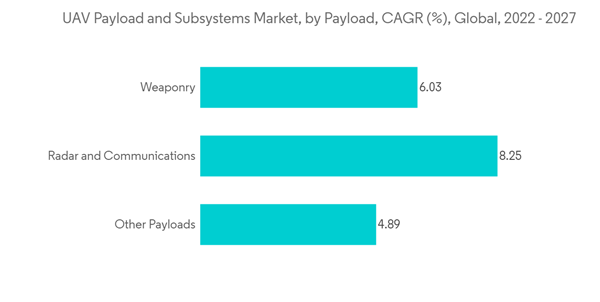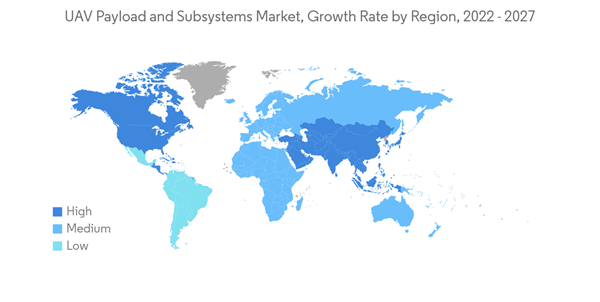The UAV payload and subsystems market is anticipated to register a CAGR of more than 12% during the forecast period.
The COVID-19 pandemic has had a negative effect on the UAV payload and subsystems market. Due to stringent regulations and lockdowns during the pandemic, there was a reduction in the components needed to manufacture UAV systems. While the COVID-19 pandemic has affected consumer shipments and hampered commercial rollout, it also augmented the usage of drones for public service responses and surveillance by national and local police forces. However, in the post-pandemic scenario, the free flow of goods and services and the opening up of borders are increasing the demand for UAV systems. Significant growth has also been witnessed in the manufacturing of UAV systems by various companies. Moreover, the changing regulatory framework in various countries and a massive upscaling of drone operations are expected to drive market growth during the forecast period.
The emergence of medium-altitude long-endurance (MALE) and high-altitude long-endurance (HALE) UAV systems has been a vital game-changer for technologically superior nations. Unmanned combat aerial vehicles (UCAVs) are being extensively employed to suppress and destroy enemy air defense, electronic attack, communication transfer, combat, search, rescue and intelligence surveillance, and reconnaissance (ISR) operations. The growing integration of weapon systems onboard UAVs is expected to propel the market's growth.
More and more sensors are being embedded in UAVs which ensures the safety and automatic navigation to perform measurements during the flight according to the mission targets. New applications and functionalities for UAV systems are growing due to the increasing demand from companies seeking to integrate the benefits of UAVs into industrial processes and this has led to various companies' manufacturing advanced onboard sensors and devices to be fitted to UAVs.
Various new and different types of sensors such as external IMu sensors, external GPS sensors, air quality sensors, fuel level sensors, temperature sensors as well as rain sensors are being increasingly designed by companies to meet the requirement of modern customers. Thus, advancements in terms of development of advanced sensors will lead to the market witnessing growth during the forecast period.
In this regard, in March 2021, Elbit Systems introduced the new variant of its Advanced Multi-Sensor Payload System (AMPS NG) for UAVs, which introduces Shortwave Infrared (SWIR) technology to the existing CCD (Charge-Coupled Device) TV sensors with a unique dual FLIR sensor design. Similarly, another company, Aerovironmenthas introduced its new imaging payload in the MANTIS range of payloads, the MANTIS i23 D multi-sensor payload. This new payload is compatible with Raven B small Unmanned Aircraft System (SUAS) and has an ultralight imaging system with dual 18 MP electro-optical sensors and 24X digital zoom. The majority of the defense OEMs integrate advanced sensors and other supporting subsystems aboard their UAV offerings to minimize R&D costs pertaining to the cross-integration of communication platforms.
Hence, vendors mainly compete on their in-house manufacturing capabilities, global footprint network, product offerings, R&D investments, and strong client base. The competitive environment in the market is likely to intensify further due to an increase in product/service extensions and technological innovations.
This product will be delivered within 2 business days.
The COVID-19 pandemic has had a negative effect on the UAV payload and subsystems market. Due to stringent regulations and lockdowns during the pandemic, there was a reduction in the components needed to manufacture UAV systems. While the COVID-19 pandemic has affected consumer shipments and hampered commercial rollout, it also augmented the usage of drones for public service responses and surveillance by national and local police forces. However, in the post-pandemic scenario, the free flow of goods and services and the opening up of borders are increasing the demand for UAV systems. Significant growth has also been witnessed in the manufacturing of UAV systems by various companies. Moreover, the changing regulatory framework in various countries and a massive upscaling of drone operations are expected to drive market growth during the forecast period.
The emergence of medium-altitude long-endurance (MALE) and high-altitude long-endurance (HALE) UAV systems has been a vital game-changer for technologically superior nations. Unmanned combat aerial vehicles (UCAVs) are being extensively employed to suppress and destroy enemy air defense, electronic attack, communication transfer, combat, search, rescue and intelligence surveillance, and reconnaissance (ISR) operations. The growing integration of weapon systems onboard UAVs is expected to propel the market's growth.
UAV Payload & Subsystems Market Trends
The Sensor Segment is Expected to Witness Significant Growth During the Forecast Period
Though the Radar and Communications segment accouted for the largest share in the market in 2021, the sensor segment is expected to witness significant growth during the forecast period. In the current scenario, the use of Unmanned Aerial Vehicles (UAVs), commonly known as drones, in the global civilian market is witnessing significant growth. This trend is due to the integration of high-performance processors, sensors, and electronic devices with lower power consumption on UAV platforms. A growing number of unmanned vehicles in the air, on the ground, and at sea represent a vast universe of sensors and sensor processing that could provide some of the most detailed intelligence information on military forces. Some of the chief enabling technologies for this new generation of connected unmanned vehicle sensor payloads include electro-optical sensors like infrared sensors, visible-light cameras, multispectral, and hyperspectral sensors. Companies are developing a new generation of technologically advanced sensors. For instance, one prominent company involved in electro-optical unmanned vehicle sensor payloads is FLIR Systems in Wilsonville, Ore. FLIR has introduced the UltraForce275-HD compact multi-sensor gyro-stabilized surveillance system for weight, power, and footprint-constrained platforms like unmanned aerial vehicles (UAVs). The gimbal weighs slightly more than 33 pounds. Similarly, Octopus ISR Systems in Riga, Latvia, offers the Epsilon 175 small gyro-stabilized electro-optical four-sensor payload for UAVs for military applications, order control, and civil uses.More and more sensors are being embedded in UAVs which ensures the safety and automatic navigation to perform measurements during the flight according to the mission targets. New applications and functionalities for UAV systems are growing due to the increasing demand from companies seeking to integrate the benefits of UAVs into industrial processes and this has led to various companies' manufacturing advanced onboard sensors and devices to be fitted to UAVs.
Various new and different types of sensors such as external IMu sensors, external GPS sensors, air quality sensors, fuel level sensors, temperature sensors as well as rain sensors are being increasingly designed by companies to meet the requirement of modern customers. Thus, advancements in terms of development of advanced sensors will lead to the market witnessing growth during the forecast period.
The Asia-Pacific Region is Expected to Witness Significant Growth During the Forecast Period
The Asia-Pacific region is expected to witness significant growth during the forecast period. There has been a significant increase in the number of usage of UAVs in China. The growing number of border conflicts coupled with various Chinese companies developing advanced UAVs that can carry higher payloads will drive the market in the near future. The UAV industry in China is witnessing growth owing to strong demand from the low-altitude economy. According to reports by China Daily, as of 2022, the Chinese drone market has been valued at 100 billion yuan or USD 14.8 billion. Since 2020, despite the COVID-19 outbreak, China's drone market has succeeded in maintaining a 30 percent growth due to contactless delivery and smart applications. Moreover, according to reports from the Civil Aviation Administration of China, by the end of 2021, there are 781,000 registered drone users, and the number of registered drones total 832,000. Various Chinese companies such as ACES, China Electronics, and Hexadrones are now engaged in developing UAVs with advanced payload systems. For instance, in November 2022, China announced the development of their new MD-22 drone which has a flight speed of 8,645 km/h, a range of 8,000 km, and a payload of 4,000 kg. This drone has been developed to test hypersonic technology in China. The other major countyr in the region, India, is engaged in acquiring homegrown drones. Moreover, the country has also launched a series of fast-track drone procurement efforts under emergency powers that will see the country spend up to 3 billion rupees (USD 36 million) for each program. Moreover, according to the Defense Ministry, orders will be fulfilled within one year after the contract has been signed. Countries in the Rest of Asia-Pacific such as Thailand, Singapore as well as Malaysia are witnessing significant improvements in terms of development as well as usage of UAVs and payload subsystems. For instance, in September 2022, the Royal Thai Navy announced that have placed an order for Hermes 900 maritime unmanned aerial vehicles (UAVs) from Israel under a contract worth USD 120 million. Moreover, the medium-altitude long-range (MALE) UAVs will be equipped with various payload systems such as maritime radar, an electro-optic payload, satellite communication (Satcom) equipment, droppable inflated life rafts, and other capabilities and intended to enable the Royal Thai Navy to perform missions such as maritime search-and-rescue and identification of suspicious activities and potential hazards. Such developments will lead to growth in terms of UAV payload and subsystems in the market during the forecast period.UAV Payload & Subsystems Market Competitor Analysis
The UAV payload and subsystems market is characterized by the presence of limited dominant vendors operating at a global level. The market is highly competitive, with players competing to gain the largest market share. Some of the major players in the UAV payload and subsystems market are AeroVironment Inc., Elbit Systems Ltd., Lockheed Martin Corporation, SZ DJI Technology Co., Ltd., and Teledyne Technologies Incorporated amongst others. It is now becoming crucial for vendors to provide state-of-the-art systems to OEMs to survive and succeed in an intensely competitive market environment.In this regard, in March 2021, Elbit Systems introduced the new variant of its Advanced Multi-Sensor Payload System (AMPS NG) for UAVs, which introduces Shortwave Infrared (SWIR) technology to the existing CCD (Charge-Coupled Device) TV sensors with a unique dual FLIR sensor design. Similarly, another company, Aerovironmenthas introduced its new imaging payload in the MANTIS range of payloads, the MANTIS i23 D multi-sensor payload. This new payload is compatible with Raven B small Unmanned Aircraft System (SUAS) and has an ultralight imaging system with dual 18 MP electro-optical sensors and 24X digital zoom. The majority of the defense OEMs integrate advanced sensors and other supporting subsystems aboard their UAV offerings to minimize R&D costs pertaining to the cross-integration of communication platforms.
Hence, vendors mainly compete on their in-house manufacturing capabilities, global footprint network, product offerings, R&D investments, and strong client base. The competitive environment in the market is likely to intensify further due to an increase in product/service extensions and technological innovations.
Additional benefits of purchasing the report:
- The market estimate (ME) sheet in Excel format
- 3 months of analyst support
This product will be delivered within 2 business days.
Table of Contents
1 Introduction
4 Market Dynamics
5 Market Segmentation
6 Competitive Landscape
Methodology

LOADING...










